中职英语工科类教案教学设计Unit10
最新中职英语基础模块教案:Unit10(第一课时

Unit 10 How can I improve my English?(第一课时教学设计)一、学情分析本单元为《英语1》(基础模块高教版)最后一单元,主要话题为如何提高英语。
在本单元模块中反复呈现英语学习中常见的各种困难并提出相关的学习建议。
职业学校的学生在英语学习上确实存在着各种困难,在如何提高英语的问题上也有着很大的困惑。
在如何提高英语的问题上也有着很大的困惑。
虽然外贸虽然外贸班的总体英语水平不错,班的总体英语水平不错,但学生普遍需要学法的完善,但学生普遍需要学法的完善,但学生普遍需要学法的完善,以期英语成绩以期英语成绩的更大提高,部分学生甚至英语水平不是很理想,更需要学法指导。
因此,教师可通过本单元的听、说、读、写各种教学活动。
一方面帮助学生掌握正确表达与英语学习相关的词汇与句型,另一方面引导学生结合自身的情况反思自己的英语学习,针对自身的学习问题选择有效的学习策略。
二、教学分析1.教学内容本课时系教材《英语1》(基础模块高教版)第十单元的第一课时,包括Lead- in + listening and speaking 两部分。
具体内容为:有关谈论英语学习中的各种困难及学习建议的词汇、谈论英语学习中的各种困难及学习建议的词汇、句型,句型,以及相关的对话。
这些内容为整个单元的学习活动提供很好的知识储备,使下面一系列的活动展开能顺利进行。
系列的活动展开能顺利进行。
而且,而且,本单元的话题是如何提高英语学习。
对于外贸专业学生来说,英语学习是重中之重,所以学生们会比较感兴趣,能积极参与探讨英语学习中存在的问题,能积极参与探讨英语学习中存在的问题,如何解决这些问如何解决这些问题,从而获得更好的促进英语提升的方法。
题,从而获得更好的促进英语提升的方法。
2. 教学重点、难点:教学重点、难点:(1)教学重点教学重点听懂并掌握有关英语学习中的各种困难及建议的词汇、句式。
听懂并掌握有关英语学习中的各种困难及建议的词汇、句式。
职业高中英语第三册Unit10语法部分教案unit10 language in use讲课讲稿

职业高中英语第三册U n i t10语法部分教案u n i t10l a n g u a g ei n u s e汨罗市职业中专学校教学方案设计(首页)时间状语一样,也要注意分词所表示的动作与谓语动作的先后关系。
当分词所表示的动作与谓语动作同时发生或几乎同时发生时,用分词的一般形式。
此时分词的逻辑主语须是句中的主语。
这样的原因状语可以换成because, as引导的原因状语,该从句谓语动词用一般过去时。
Not knowing how to work out the difficult physics problem, he asked the teacher for help.因为不知道如何解这道物理难题,他求助老师。
= Because he didn't know how to work out the difficult physics problem, he asked…help.3.当分词表示的动作发生在谓语动作之前,可以用现在分词的完成式在句中作原因状语,其逻辑主语须为句中的主语,该短语的作用相当于一个原因状语从句。
该从句的谓语动词须用完成时。
如:Having lived with the girl for 5 years, we all know her very well.= Because we have lived with the girl for 5 years, we all know her very well.因为与那个女孩一起生活了五年,我们都非常了解她。
4、现在分词短语在句中可以作条件状语,其逻辑主语须为句中的主语,该短语相当于一个条件状语从句。
Working hard, you'll succeed. = If you work hard, you'll succeed. 如果你努力工作,你会成功的。
Turning to the left, you will find the path leading to the park.= If you turn to the left, you will find the path leading to the park.如果转向左边,你将找到通向公园的小道。
中职职业英语 基础英语模块第十单元教案
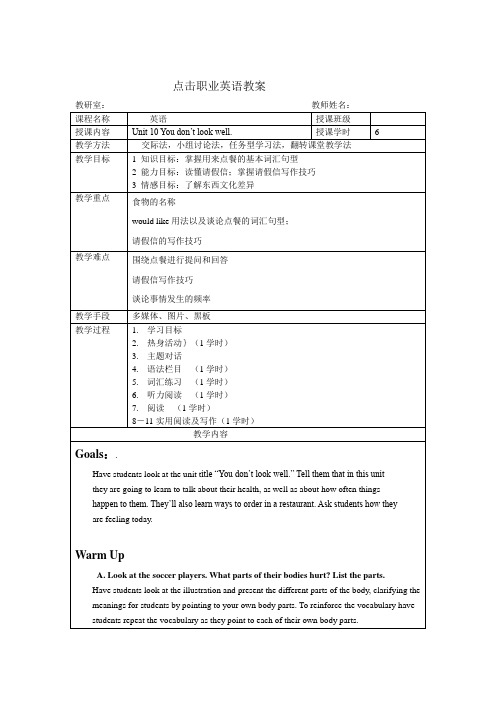
点击职业英语教案教研室:教师姓名:Andy is not feeling well.GrammarOrdering in a restaurantE xplain that ’d is the contracted form of would. Direct students’ attention toLanguage Zoom In to reinforce this point and model the pronunciation for them.Focus students’ attention o n the chart and go through the affirmative statements, yes/no questions, and short answers.Explain that in affirmative short answers we don’t use the contracted form of would (’d).’d = wouldA.PAIR WORK Complete the conversation. Then take turns. Role-playthe conversation.Have students complete the dialog using expressions from the chart above.Answer key: Would, like, like, What, like, I’dB. PAIR WORK Take turns. Order items on the menu.Working with their partner, have students take turns playing the role of waiter or waitressand customer. Tell students that the customer should order items from the menu and thewaiter or waitress should write down the order. Then they should check together that theorder is correct. Tell students to use the dialog in Exercise A to help them.C. Pair work. Practice these dialogs with your partner.Amy: I’m hungry.John: Me too.Amy: Let’s get something to eat.John: Sounds good to me.Amy: Would you like to go to that new Chinese restaurant?John: Sure.Talking about how often things happenDraw the diagram on the board with the numbers along the baseline as percentages(0%, 25%,50%, 75%, 100%).Explain to students that they are going to learn to talk about how often they do things.Start with 100% and tell them when they do something every day, or 100% of thetime, we use the expression always.A. Read the lunch schedules and complete the sentences. Use never, rarely, sometimes,usually, or always.Elicit from students when we use always(= 100%), usually (= 75%),sometimes (= 50%–75%), rarely (= less than 25%), and never (= 0%).Have students look at the chart of lunch schedules and ask them “How often does Mikehave lunch at a restaurant?” “And at the office?” “And at home?” “What about at school?”Responses:sometimes, sometimes, rarely, neverB.PAIR WORK Take turns. Ask and answer questions about Mike, Ken, Nathan,and Ben.Organize students into pairs and have them look at the example. Tell students to take turns asking questions similar to those in Exercise A about Mike, Ken, Nathan, and Ben. Partners should answer the questions using the information in the chart.C. Listen. What do you hear? Check the correct box.Tell students they are going to listen to six sentences with the adverbs of frequency andshould listen for each adverb.Vocabulary in ContextTalking about health problems and giving adviceHave students look at the illustrations on this page and tell students these people are not。
中职英语基础模块2(新课标版)教案:Unit10 Why was it built 01

Unit 10 Why was it built(第一课时教学设计)一、教材分析1.教学内容第十单元的第一课时,包括Lead-in & Listening and speaking两部分,具体内容为:了解有关著名的建筑物,听懂关于著名建筑物的建造时间、所在位置及其他简单信息。
2.教学重点、难点⑴教学重点听懂关于著名建筑物的简单信息,并掌握有关表达建筑物的建造时间、所在位置等简单信息的词汇、句型。
⑵教学难点获得在相对真实的情境下用合适的方式和语句询问和回答有关建筑物信息的能力。
三、教学目标1.知识目标(1)了解世界著名建筑物的专有名词,如:the Palace Museum, the Golden Gate Bridge, Stonehenge, Sydney Opera House, the Pisa Tower, the Taj Mahal etc.(2)掌握与著名建筑物有关的词汇和短语,如guide, tourist, design, locate, revolution, pyramid, stair, expert, keep out, collection, congress,include, more than, rebuild, describe, description, electricity, etc(3)掌握表达建筑物的建造时间、所在位置等简单信息的词汇、句型。
如:①asking for some information of the famous building:Where was it built?When was it built?Who designed it ?How was it built?Why was it built?.What was it used for?How long was it?②Giving some information of the famous building:It was started in…It was completed in …It was designed by…四、教学步骤Step One Lead-in (7-8m)Show some symbols and let the students tell which country the famous building symbol stands for.Step Two Listening and speaking1. Listen and decide on the relationship of the speakers.2. Listen and circle the questions asked in the dialogue3. Listen again and complete the fact file4. Read and underline. Practice the dialogue with partners and then underline the sentences used to ask information about Statue of LibertyStep Three Development activities1. Give the following cards to the students. 0ne student acts as a tour guide , the other student acts as a tourist.(1) Key vocabulary(2) Sentence structure:Where was it built?When was it built?Who designed it ?How was it built?Why was it built?.What was it used for?How long was it?Step Four Homework(1) Read and copy the new words of this part.(2) Practice dialogues with your classmates after class.(3) Do Exercise Book P93-94.板书设计Unit10 Why was it built?(第二课时教学设计)一、教材分析1.教学内容阅读著名建筑物的故事,读懂和理解关于著名建筑物---美国国会图书馆的故事,并能有条理地讲解美国国会图书馆的历史。
中职英语第一册教案 unit10 make a choice Reading and writing

Step2Pre-reading
1.Teach some new words and phrases.
T: Let’s guess the meanings of the words and phrases. If you get the right meaning, you’ll get 1 point.
1.Teach some new words and phrases.
Read the words
Recite the words and phrases
Skim the passage
Have Ss answer the questions on the screem.
Help and check.
2. grasp the main idea of the article,find out the topic sentences and the supporting sentences.
3. get the structure of the article.
4. know quick decisions may not good decisions.
1.Ask the Ss read the passage for the third time.
T: If you were the decision-maker, you have to make decisions about buying a laptop and finding a room-mate. What are you going to do?
最新中职英语基础模块教案:Unit10(第二课时)

United10 How can I improve my English?(第二课时教学设计)一、教材分析1. 教学内容本课时系教材《英语1》(基础模块高教版)第十单元的第二课时,包括reading and writing 部分。
其中阅读材料分两部分。
具体内容分别为张晓波就自己对英语学习看法及学习难题Prof Learning 的QQ留言,和Prof Learning 的QQ留言回复。
这些内容均是针对单元话题,分析英语学习存在问题,解决问题。
通过话题系列任务的完成,促使学生思考英语学习的最佳方法。
古人云,“授人鱼,不如授人以渔”,方法的探究和指导是学生学习有效性的最好保障。
并且,学法指导对任何学科都是必要的,可以引导学生探究自身学习上的不足,把学法探究推广到各学科的学习上,专业知识的学习上,全面提高学习能力。
2.教学重点、难点(1)教学重点能读懂描述英语学习中常见困难及相关建议的句式,并能获得关键信息,完成活动相关任务。
(2)教学难点能正确表达针对英语问题的相关建议。
二、教学目标:1.知识目标(1)掌握讨论英语学习及建议相关的词汇:become; more and more; important; improve; do well in; come across; ask for directions in English; repeat; practice; have a lot fun; etc (2)掌握讨论英语学习、征求建议和给出建议的句型:It’s not easy to learn English.I can’t always understand them.What can I do?Can you give me some advice?You should try to listen for the important point.You can ask them to repeat again.You may listen to some English songs.2.能力目标(1)学生能读懂阅读材料,并能赢获取的关键信息完成相应的任务。
中职英语教案unit10 listening and speaking
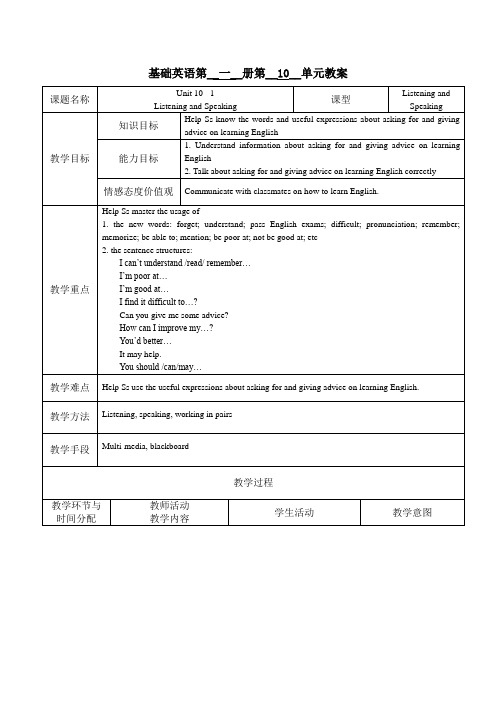
Listening and speaking
Activity 4 Listen and match:
Activity 5 Read and underline:Make sure students understand them.
Activity 6 Practice the dialogue with your partner.
教学手段
Multi-media, blackboard
教学过程
教学环节与时间分配
教师活动
教学内容
学生活动
教学意图
Step 1
Lead in
1. Make a survey about learning English. The teacher will ask students many questions:eg.
Name
Problem
Activity 12Discussin groups of four..
Find out three most common problems and decide on efficientsolutions.Write them down in the form.
Problem
Solution
To train the Ss’ listening ability of predicting and grasping the key points.
Step4
Summary
Make a short summary of the group work.
Our survey shows that the most common problem we have in using English is that __________. Many classmates also have trouble in/with ________.Some find it difficult to ________.In our opinion, to solve these problems, we should__________.
中专英语教案--unit 10
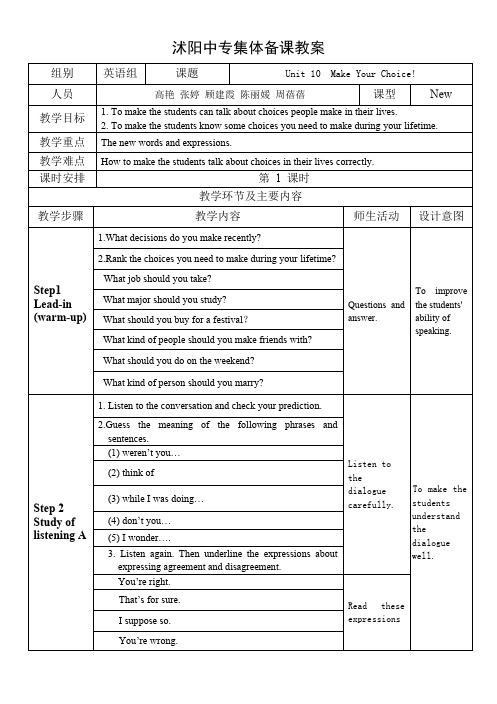
组别 英语组
课题
Unit 10 Make Your Choice!
人员 教学目标 教学重点 教学难点 课时安排
教学步骤
高艳 张婷 顾建霞 陈丽媛 周蓓蓓
课型
New
1. To make the students can talk about choices people make in their lives. 2. To make the students know some choices you need to make during your lifetime.
expressing agreement and disagreement. You’re right.
Listen to the dialogue T To make the carefully. students
understand the dialogue well.
That’s for sure. I suppose so.
To make the students understand the dialogue.
Qs: what’s your major? What jobs can you take after graduation? What are the advantages and disadvantages of each job?
To make the students can express agreement and disagreement correctly.
Step 3 Study of listening B
1. Listen and circle the correct answer. 2. Listen and circle the best answer 3. Listen again and circle the items the man ordered. 4. Read the menu in Activity 7, then answer the questions.
最新中职英语第一册教案:Unit10FunTime01英语
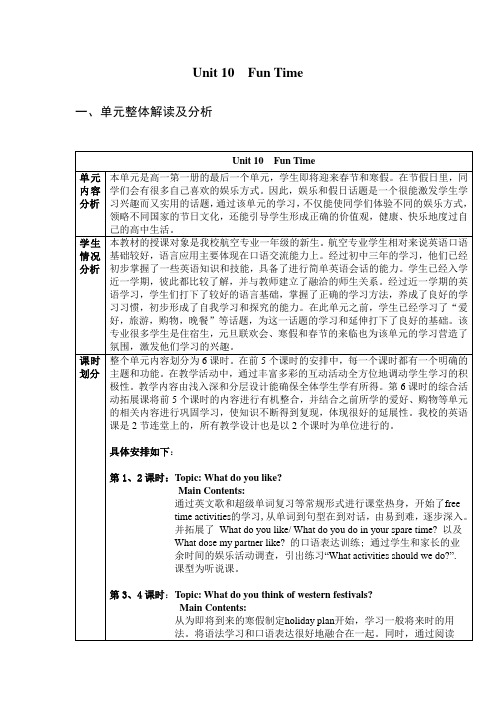
in….
小火车游戏的方
法不仅让学生动
起来,使更多的
小组间能够通过提 学生有参与的机
示,将此4句话组合 会;
成一个小对话,进
行一问一答练习。 从单词到句型再
到问答训练,每
一步都为后一步
的学习搭好梯
子,给一个抓手。
11’ Reading and 1. 给出小对话。 并播放该对 听录音,快速的浏 为了降低难度,
1. 各种业余活动的英文单词;
重点 教学 难点
2. 关于自己喜好和询问别人喜好的业余生活及休闲娱乐活动的英语句型表达。 英文倡议书的书写和表达
教学 question and answer,carousel
方法
学习 同伴互助学习
方法
教学 多媒体展示台、PPT 课件
媒体
教学过程
预设 时间
1’
教学环节
教师活动
and speaking ②)
学生快速的找出刚 学生。
才所学的关键句
2. 提问:哪些句子是刚才我 型。记下本节课的 学习本节课所学
们学习过的?
重点句型。
关键句型。
3. 要求学生和同伴一起练习 并尝试将带下划线 替换的方式很好
对话。
部分的单词根据自 实现了知识的复
(自由选择原文朗读或者 己的能力和喜好进 现,自由选择不
具体安排如下:
第 1、2 课时:Topic: What do you like?
Main Contents: 通过英文歌和超级单词复习等常规形式进行课堂热身,开始了free time activities的学习,从单词到句型在到对话,由易到难,逐步深入。 并拓展了 What do you like/ What do you do in your spare time? 以及 What dose my partner like? 的口语表达训练; 通过学生和家长的业 余时间的娱乐活动调查,引出练习“What activities should we do?”. 课型为听说课。
最新中职英语第二册教案:Unit10Huntingforajob03英语

I have studied …
I worked as…
I would be very happy if you could
give me an interview.
Please contact me at…
1)布置任务:
What does this letter talk about?
2)学生小组阅读,讨论答案。
2.细节阅读
布置任务形式:小组比赛
1)小组阅读,找出不认识的单词与词组。
2)在小组内互帮互助,学习新单词
和词组的发音及意思。
3)小组讨论,回答问题:
a. What position does Zhang Yi want to get?
板书设计
Sentence patterns: Resume
Name
Position applied for
Education background
Major
Work experience
Phone number
I’m writing to apply for a position…
I’m a s空。
4.根据个人情况,填写简历表。
5. 2人一组,口头
练习求职信。
以表格形式提炼文章细节,同时为下一课时做铺垫。
既复习课文内容,又练习阅读和翻译能力。
掌握简历表的填写,既为写好求职信做铺垫,又能在将来的实际求职中使用,做到学以致用。
3’
总结
1.求职信中常用的表达方式。
2.正确填写简历表。
2)培养学生的自主学习能力和合作精神。
教学
重点
1.掌握求职信中的常用表达方式;
中职英语工科类教案教学设计Unit10
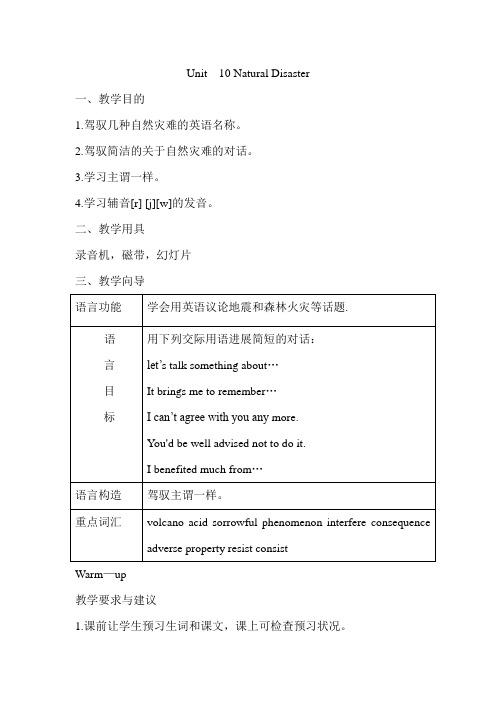
Unit 10 Natural Disaster一、教学目的1.驾驭几种自然灾难的英语名称。
2.驾驭简洁的关于自然灾难的对话。
3.学习主谓一样。
4.学习辅音[r] [j][w]的发音。
二、教学用具录音机,磁带,幻灯片三、教学向导Warm—up教学要求与建议1.课前让学生预习生词和课文,课上可检查预习状况。
2.课上用幻灯片引导学生完成配图。
3.分组完成课文中的提问。
Pronunciation Practice带着学生练习辅音[r][j][w],列举含有这些元音发音的单词,比照它们发音的不同。
Listening and Speaking一、教学重点1. 学会用英语议论地震和森林火灾等话题。
2. 学会用建议的口吻沟通。
二、教学建议1. 依据课文的听力材料练习对话。
2. 进展听力练习,填空。
3. 角色扮演(Role Play)(1)明确口语活动的任务,要求学生细致阅读对话。
必要时可做简洁的对话示范。
(2)学生成对活动,交换角色练习对话。
(3)老师驾驭学生练习状况,解答学生提出的问题。
(4)老师和学生模拟议论地震,示范引导学生。
(5)总结学生的表现,刚好订正学生练习中的错误之处。
三、练习参考答案A2. Listen and fill the blanksstarted department put the fire out handle set up 65 help availableB2. Answer the questions(1) 失衡,反常(2) forest fires are part of nature,and clean up the left of the leaf that collects on the forest floor.(3) forest fires are part of nature, and we shouldn’t try to interfere except, of course, to save homes and lives.3. Complete the following sentences(1)affected(2)escape(3)tsunami(4)volunteer4. 略5. Listen to the dialogue and answer the questionsshaking breaking whit the table food first-aid case solid house 听力原文A2. Listen and fill in the blanks.A fire started on some grassland near a farm in Canada. The fire department from the nearby town was called to put the fire out. The fire proved to be more than the small town fire department could handle, so someone suggested that a rural volunteer fire company be called. Sincethe company was set up completely by the men over 65, there was doubt that they would be of help. But with no other help available, the farmer called the fire company away.B5. Listen to the dialogue and complete the form below.Amy: Bill, it was a strong earthquake! The house was shaking, the window breaking.Bill: I know. It was terrible. I saw your face turn whit as you ran and got under the table.Amy: I admit I feared. But it wasn’t a time for us to be careless. It’s better to be cautious. There might be aftershocks.Bill: Or an even bigger quake!Amy: To play it safe, let’s turn off the gas and electricity.Bill: Right. Let’s get the earthquake necessaries already. It’s in the kitchen. It has food, flashlights, and a first-aid case.Amy: Let’s turn on the radio for news. I guess the quake measures at least 5.Bill: Who know what might happen tomorrow, next month or next year? After all, this city is said to be located in an earthquake zone Amy: There hasn’t been much activit y for dozens of yearsBill: But a major quake may hit at any time.Amy: I think we’d better move to a solid house.Bill: That’s right.Language Bank带着学生练习记忆这些日常口语,并让学生课下反复练习,定时抽查。
中职英语(人教版)授课教案:Unit 10
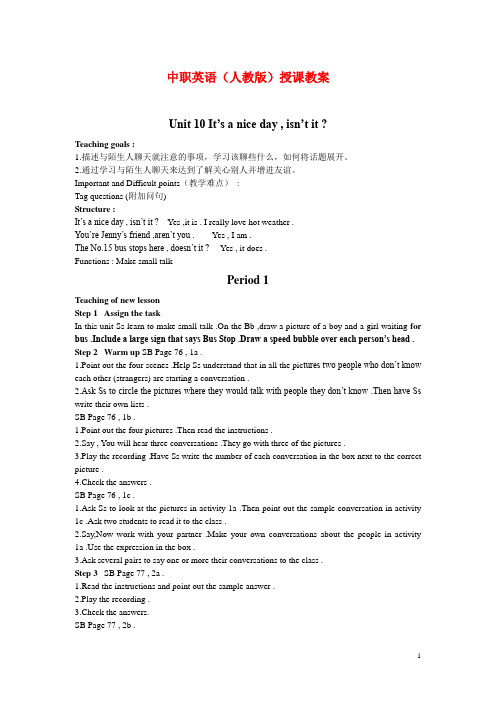
中职英语(人教版)授课教案Unit 10 It’s a nice day , isn’t it ?Teaching goals :1.描述与陌生人聊天就注意的事项,学习该聊些什么,如何将话题展开。
2.通过学习与陌生人聊天来达到了解关心别人并增进友谊。
Important and Difficult points(教学难点):Tag questions (附加问句)Structure :It’s a nice day , isn’t it ?Yes ,it is . I really love hot weather .You’re Jenny’s friend ,aren’t you .Yes , I am .The No.15 bus stops here , doesn’t it ?Yes , it does .Functions : Make small talkPeriod 1Teaching of new lessonStep 1 Assign the taskIn this unit Ss learn to make small talk .On the Bb ,draw a picture of a boy and a girl waiting for bus .Include a large sign that says Bus Stop .Draw a speed bubble over each person’s head . Step 2 Warm up SB Page 76 , 1a .1.Point out the four scenes .Help Ss understand that in all the pic tures two people who don’t know each other (strangers) are starting a conversation .2.Ask Ss to circle the pictures where they would talk with people they don’t know .Then have Ss write their own lists .SB Page 76 , 1b .1.Point out the four pictures .Then read the instructions .2.Say , You will hear three conversations .They go with three of the pictures .3.Play the recording .Have Ss write the number of each conversation in the box next to the correct picture .4.Check the answers .SB Page 76 , 1c .1.Ask Ss to look at the pictures in activity 1a .Then point out the sample conversation in activity 1c .Ask two students to read it to the class .2.Say,Now work with your partner .Make your own conversations about the people in activity 1a .Use the expression in the box .3.Ask several pairs to say one or more their conversations to the class .Step 3 SB Page 77 , 2a .1.Read the instructions and point out the sample answer .2.Play the recording .3.Check the answers.SB Page 77 , 2b .1.Read the instructions and point to the lettered list of sentences .2.Ask different students to read the lines of the conversation to the class .3.Play the recording .Ask Ss write the letter of each line of conversation in the correct place .4.Check the answers .SB Page 77 , 2c .1.Read the instructions for the activity .2.Point to the conversations in activity 2b .Ask a pair of students to read the conversations to the class .Then ask all students to practice the conversation in pairs .3.Point out the questions in the box .4.Then have Ss work in pairs .5.Ask several pairs to come to the front of the room and say their conversations to the class . Step 4 Grammar Focus1.Review the grammar box .Ask students to read the questions and answers .2.Ask Ss to give other examples of small talk that use tag questions .Help Ss find the correct Yes or No short answer to go with each question .Exercise designing for Period 1汉译英1.天看起来要下雨了,是吗?是的,但是我忘带雨伞。
最新中职英语第二册教案:Unit10Huntingforajob02英语

4)提醒学生注意礼貌用语和穿着、仪态等方面。
4.播放录音,由学生完成判断正误题。
5.听录音,完成练习4—用词的适当形式填空。(如果有问题,可再听一遍。)
1)
a)学生以小组为单位讨论问题,自学这些词语,在互教互学中掌握这些词的发音和意义。
b)提出问题,跟读单词。
2)
a)明确任务,做
好准备。
b)学生观看视频
分层次练习,增强基础稍差学生的信心和成就感。
肯定优点,指出不足,为以后的面试做好充分准备。
4’
自我检测
1.组织学生自测,指导学生进行组内学习。
2.教师提问部分学生,反馈自测、互助效果。
1.
1)对照学案上的词汇和句型自己检测,在已掌握的旁边标示笑脸。
2)针对不会的词汇句型在小组内开展互助学习将不熟练的词汇和句型进一步掌握好。
2.思考:
如何填写个人简历表。
1.记录
2.思考并在课后查找相应资料。
1.掌握本课时内容。
2.培养学生自主学习能力,为后面的授课做铺垫。
教学反思
在本节课的讲授中,通过任务型教学、情景教学全面提高学生的英语听说能力,注重学生的口语交际能力和合作能力的培养。针对学生的英语水平的不同,设计了相应的教学活动和任务要求,并建立了不同的评估标准。通过设立真实的面试场景,让学生通过自主学习和合作学习,掌握一些面试场合的交际用语,学到一些面试技巧,增强学生面试信心,提高面试时的应对能力,顺利通过面试,找到满意的工作。通过推选面试官及应聘者,以及教师和学生共同选出聘用者,激发了学生的学习兴趣。
Do you have any work experience? I worked in…
1)读招聘启事,思考如何组织进
最新中职英语第二册教案:Unit10Huntingforajob01英语

第1课时
教学
目标
1.知识目标:
1)正确拼读单词;
2)掌握一些简单有关面试的句型。
2.能力目标:运用句型,正确回答一些简单的面试问题。
3.情感目标:
1)初步掌握面试技巧,增强面试信心;
2)培养学生自主学习性和团队精神。
教学
重点
1.记住新单词;
2.用句型回答简单的面试问题。
教学
难点
1.完成单词练习,熟练掌握单词;
3.要求学生将所学的基本句型组成简短的对话,进行情景模拟。
4.设立不同的2组情景,进行模拟训练。
1.根据提示练习句型。
2.在无提示的情况下练习,检查句型掌握情况。
3.通过讨论学习和小组合作学习,将句型整合成简短对话,进行简单的情景模拟。
增强自信心。
检查句型掌握情况。
提高学生的自主学习能力。
3’
总结
1.单词复习。
掌握单词和句型,为后面的学习打好基础。
为下一课时铺垫。
教学反思
本课时重点讲授单词和一些最基本的面试用语,为下一课时的听说练习扫清单词障碍。通过2个小游戏来掌握单词,提高学习的趣味性。通过小组学习和讨论学习,提高学生的自主学习能力,增强合作精神。在单词和句型学习时,练习由简到难,有层次性和递进性,便于学生接受。设置情景教学,将学习引入生活,使得学生能“做中学,学中做”,有实践性和实用性。
3.同伴相互问答,练习基本句型。
1.听录音,填单词。
2.小组讨论答案。
3.口语练习。
降低难度。
讨论学习和合作学习。
10’
句型学习
1.提出问题:
面试时面试官会问到哪些具体
问题?
2.根据上面的听力练习,引出基本句型。
中职英语 unit10real life skills 教案
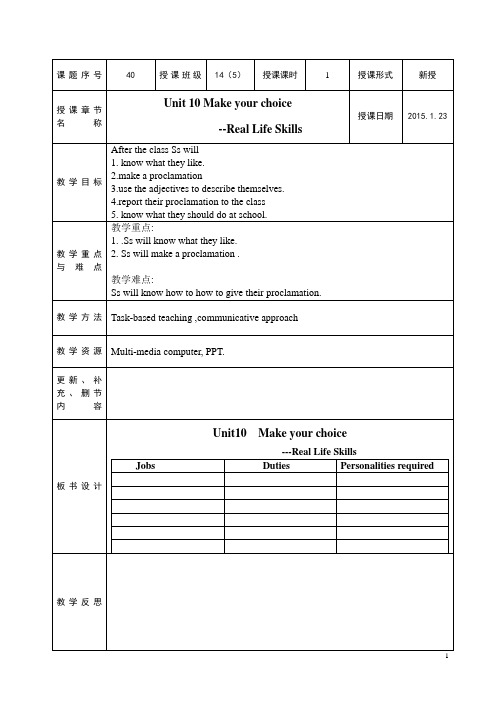
Homework
Greet the T.
Ss say the words according to the pictures.
think and discuss
report.
Make conversations
Do exercise
Correct their mistakes
e the adjectives to describe themselves.
4.report their proclamation to the class
5. know what they should do at school.
教学重点与难点
教学重点:
1. .Ss will know what they like.
2.Ask Ss toreport their work to the class.
3.Have the Ss make conversations with their partners with the help of the example in Part3.
Step 3 Make areport1.Enlighten and tell Ss how to give a proclamation.
Teach how to describe oneself.
Help Ssdo activity2.
report their work
make conversations
Guide Ssto finish proclamation.
Have Ss report their proclamation to the class
Ask Ss to choose the right adjectives to describe themselves.
中职职业英语 基础英语模块第十单元教案

点击职业英语教案教研室:教师姓名:Andy is not feeling well.GrammarOrdering in a restaurantE xplain that ’d is the contracted form of would. Direct students’ attention toLanguage Zoom In to reinforce this point and model the pronunciation for them.Focus students’ attention o n the chart and go through the affirmative statements, yes/no questions, and short answers.Explain that in affirmative short answers we don’t use the contracted form of would (’d).’d = wouldA.PAIR WORK Complete the conversation. Then take turns. Role-playthe conversation.Have students complete the dialog using expressions from the chart above.Answer key: Would, like, like, What, like, I’dB. PAIR WORK Take turns. Order items on the menu.Working with their partner, have students take turns playing the role of waiter or waitressand customer. Tell students that the customer should order items from the menu and thewaiter or waitress should write down the order. Then they should check together that theorder is correct. Tell students to use the dialog in Exercise A to help them.C. Pair work. Practice these dialogs with your partner.Amy: I’m hungry.John: Me too.Amy: Let’s get something to eat.John: Sounds good to me.Amy: Would you like to go to that new Chinese restaurant?John: Sure.Talking about how often things happenDraw the diagram on the board with the numbers along the baseline as percentages(0%, 25%,50%, 75%, 100%).Explain to students that they are going to learn to talk about how often they do things.Start with 100% and tell them when they do something every day, or 100% of thetime, we use the expression always.A. Read the lunch schedules and complete the sentences. Use never, rarely, sometimes,usually, or always.Elicit from students when we use always(= 100%), usually (= 75%),sometimes (= 50%–75%), rarely (= less than 25%), and never (= 0%).Have students look at the chart of lunch schedules and ask them “How often does Mikehave lunch at a restaurant?” “And at the office?” “And at home?” “What about at school?”Responses:sometimes, sometimes, rarely, neverB.PAIR WORK Take turns. Ask and answer questions about Mike, Ken, Nathan,and Ben.Organize students into pairs and have them look at the example. Tell students to take turns asking questions similar to those in Exercise A about Mike, Ken, Nathan, and Ben. Partners should answer the questions using the information in the chart.C. Listen. What do you hear? Check the correct box.Tell students they are going to listen to six sentences with the adverbs of frequency andshould listen for each adverb.Vocabulary in ContextTalking about health problems and giving adviceHave students look at the illustrations on this page and tell students these people are not。
最新中职英语第一册教案:Unit10FunTime03英语
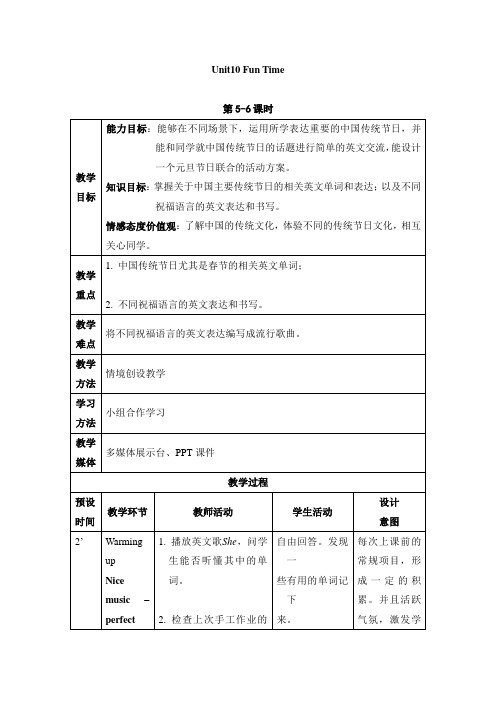
Unit10 Fun Time 第5-6课时2. Try to introduce your Spring Festival.Write a short composition about it.3. Try to introduce the differences between western festivals and Chinese festivals.Write a short composition about it.(选做其中一项,可以自己独立完成,也可以和同伴一起完成,也可以小组完成)教学反思本次课的教学设计很好的将本单元的内容进行了拓展和延伸,整节课通过教师有序指导、生动活泼的启发教学,充分调动起学生兴趣,激发学生积极的参与、体验、合作与交流,充分发挥了学生的主体作用。
综合活动课通过多样化的活动设计,给予学生合理的语境和重要的关键词,引导学生们在欢乐的气氛中回顾和运用本单元所学。
板书设计Unit 10 Fun TimeTopic 3What is our festival like?ⅠWhat is the Spring Festival like?On that day, people will do some special things like following:A. Visiting relativesB. Having a big dinnerC. Taking the lucky money (red pocket)D. Posting the Spring Festival couplets.Ⅱ About Chinese traditional festivalsA. Spring FestivalB. Mid-Autumn FestivalC. Dragon-Boat FestivalD. Tomb-Sweeping DaySuper words--------Additionalwords:---------。
- 1、下载文档前请自行甄别文档内容的完整性,平台不提供额外的编辑、内容补充、找答案等附加服务。
- 2、"仅部分预览"的文档,不可在线预览部分如存在完整性等问题,可反馈申请退款(可完整预览的文档不适用该条件!)。
- 3、如文档侵犯您的权益,请联系客服反馈,我们会尽快为您处理(人工客服工作时间:9:00-18:30)。
Unit 10 Natural Disaster一、教学目标1.掌握几种自然灾害的英语名称。
2.掌握简单的关于自然灾害的对话。
3.学习主谓一致。
4.学习辅音[r] [j][w]的发音。
二、教学用具录音机,磁带,幻灯片三、教学向导Warm—up教学要求与建议1.课前让学生预习生词和课文,课上可检查预习情况。
2.课上用幻灯片引导学生完成配图。
3.分组完成课文中的提问。
Pronunciation Practice带领学生练习辅音[r][j][w],列举含有这些元音发音的单词,对比它们发音的不同。
Listening and Speaking一、教学重点1. 学会用英语谈论地震和森林火灾等话题。
2. 学会用建议的口吻交流。
二、教学建议1. 根据课文的听力材料练习对话。
2. 进行听力练习,填空。
3. 角色扮演(Role Play)(1)明确口语活动的任务,要求学生仔细阅读对话。
必要时可做简单的对话示范。
(2)学生成对活动,交换角色练习对话。
(3)教师掌握学生练习情况,解答学生提出的问题。
(4)教师和学生模拟谈论地震,示范引导学生。
(5)总结学生的表现,及时纠正学生练习中的错误之处。
三、练习参考答案A2. Listen and fill the blanksstarted department put the fire out handle set up 65 help availableB2. Answer the questions(1) 失衡,反常(2) forest fires are part of nature,and clean up the left of the leaf that collects on the forest floor.(3) forest fires are part of nature, and we shouldn’t try to interfere except, of course, to save homes and lives.3. Complete the following sentences(1)affected(2)escape(3)tsunami(4)volunteer4. 略5. Listen to the dialogue and answer the questionsshaking breaking whit the table food first-aid case solid house 听力原文A2. Listen and fill in the blanks.A fire started on some grassland near a farm in Canada. The fire department from the nearby town was called to put the fire out. The fire proved to be more than the small town fire department could handle, so someone suggested that a rural volunteer fire company be called. Sincethe company was set up completely by the men over 65, there was doubt that they would be of help. But with no other help available, the farmer called the fire company away.B5. Listen to the dialogue and complete the form below.Amy: Bill, it was a strong earthquake! The house was shaking, the window breaking.Bill: I know. It was terrible. I saw your face turn whit as you ran and got under the table.Amy: I admit I feared. But it wasn’t a time for us to be careless. It’s better to be cautious. There might be aftershocks.Bill: Or an even bigger quake!Amy: To play i t safe, let’s turn off the gas and electricity.Bill: Right. Let’s get the earthquake necessaries already. It’s in the kitchen. It has food, flashlights, and a first-aid case.Amy: Let’s turn on the radio for news. I guess the quake measures at least 5.Bill: Who know what might happen tomorrow, next month or next year? After all, this city is said to be located in an earthquake zone Amy: There hasn’t been much activity for dozens of yearsBill: But a major quake may hit at any time.Amy: I think we’d bet ter move to a solid house.Bill: That’s right.Language Bank带领学生练习记忆这些日常口语,并让学生课下反复练习,定时抽查。
Reading and Writing一、教学建议语言运用要求:理解并准确流畅地朗读课文,完成教材和练习册中本单元所规定的练习题。
二、词汇学习(1) consequence n. 结果,后果,重要(性)Happiness is a consequence rather than a reward.幸福不是报偿,而是结果。
(2) adverse adj. 不利的,有害的,相反的,逆的He is adverse to going abroad.他反对出国。
(3) property n. 财产,所有物,房地产,特性These plants have medicinal properties.这些植物具有药物效用。
(4) resist v. 抵抗,对抗This building is designed and constructed to resist destruction by abomb.这个建筑的设计和建造可抵抗炸弹破坏的。
(5) consist vi. 组成,构成,存在于The entire world consists of matter.整个世界都是由物质组成的。
三、课文理解(1)A natural disaster is the consequence of a hazardous event, occurring when human activities are affected by adverse natural phenomena such as flood, drought, hailstorm, heat wave, forest fire, typhoons, tornado, tsunami and mudslides, or volcanic eruption.当人类活动受到如洪水,干旱,冰雹,热浪,森林火灾,台风,龙卷风,海啸和泥石流,或火山爆发这些自然现象的不利影响时,自然灾害作为一个危险事件的后果会随之发生。
这个句子较长,occur的现在分词形式引导一个定语从句,修饰disaster,这个定语从句里又包含了一个时间状语从句。
四、课文参考翻译灾难的后果当人类活动受到如洪水,干旱,冰雹,热浪,森林火灾,台风,龙卷风,海啸和泥石流,或火山爆发这些自然现象的不利影响时,自然灾害作为一个危险事件的后果会随之发生。
而由此产生的死亡或财产损失则依赖于人类抵御灾害的能力。
有时两个看似不同的灾害可能是相互关联的。
例如,海底地震可能导致海啸。
当一个地区长期干旱时,有可能在另一个地区正在发大洪水。
对人类来说有必要了解自然灾害并与之作斗争。
干旱是一个由多种干燥条件组成的长期的天气模式。
在此期间,粮食和水的供应会发生短缺,像饥荒等其他情况就可能爆发。
干旱可能持续数年,尤其对依靠农业生存的居民区会造成损害。
在一个地方大量的雨水之后的洪水,可能是许多不同情况造成的结果。
洪水可能由包括雷电交加的暴风雨在内的暴雨,大量冰雪的快速融化,或由于河流淬不及防的逆流引起的下游地区河道膨胀等原因造成的。
造成洪水的另一个可能性原因是的人造水坝决堤。
五、课后参考答案3. Fill in the blanks with the words in the box.(1)Seemingly(2)eruptions(3)consequences(4)relate(5)famine. (6)hazardous(7)resist(8)propertyGrammar根据课文语法知识重点学习主谓一致。
练习参考答案1. 2. 3. 4. 5. 6. 7. 8. 9. 10.Culture and Entertainment描述海啸一阵奇怪的嘶嘶声弥漫在空中,之后是震耳欲聋的咆哮,高达20米的巨大的黑色水墙以每小时450千米的速度冲向海岸,目击者这样形容这场灾难。
对于那些在沙滩上日光浴的人和在户外海滨咖啡馆吃晚餐的人来说,没有逃生的机会。
这场海啸是在距离苏门答腊岛海岸地下9个地震深度的强力之后发生的,其力量横扫远至内陆两千米,连同渔船、汽车、电车、火车、早起购物的人们以及海滩小屋,一起夷为平地。
许多当地的居民,包括许多儿童,冲向海滩捡那些由第一波巨浪抛到岸边的鱼。
在他们没能回到安全地之前,另一波更大的波浪就把他们卷入死亡的海洋。
当最大的水浪最终退回到海洋的时候,尸体到处都是,许多尸体挂在树上。
在印度洋边缘地区和远至肯尼亚和索马里海域,至少有14万人死于这场洪水。
一千多人仍旧失踪,在这些人中有200个印度尼西亚渔夫。
在印度、印度尼西亚、斯里兰卡和泰国,数百个小渔村断掉了纯净水、食物以及药物。
